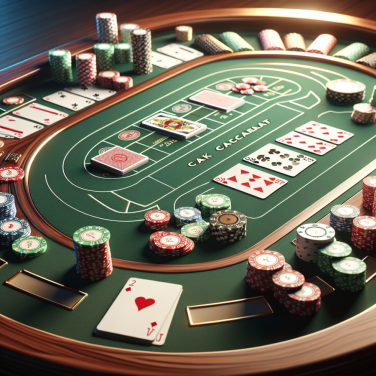Maximizing Returns: Leveraging Payout Knowledge for Baccarat Success
To truly maximize your returns in baccarat, it is essential to go beyond a basic understanding of the game's rules and into the strategic leverage of payout knowledge. Knowing the odds, managing your bankroll, and making informed betting decisions can significantly improve your chances of success in this fast-paced game.
One of the first steps to leveraging payout knowledge in baccarat is to grasp the probabilities and payouts of the three main bets: Banker, Player, and Tie. The Banker bet typically has a 1.06% house edge, offering the best odds for players, thus a safer bet for steady gains over time. The Player bet comes with a slightly higher house edge of 1.24%. On the other hand, the Tie bet, while attractive with an 8:1 or 9:1 payout, has a much higher house edge of around 14.36%, making it an enticing but riskier option.
Understanding commission is equally critical. Since betting on the Banker is more likely to win, casinos apply a 5% commission to winnings on this bet. To work around this, smart players are always calculating the commission into their potential profits and adjusting their wagers accordingly. They also stay vigilant for tables that offer lower commissions, which can significantly affect their long-term winnings.
Another advanced tactic involves taking advantage of betting systems such as the Martingale, Fibonacci, or Paroli. These systems regulate your bets according to the results of previous rounds. For example, the Martingale requires you to double your bet after each loss, which theoretically recovers losses when you eventually win. However, each system carries risks, and a thorough understanding of each will enable you to choose one that aligns with your risk tolerance and playing style.
Bankroll management is crucial in maximizing returns. Set strict limits for your wins and losses and stick to them. This discipline will prevent you from chasing losses or gambling away your winnings. Experienced players also recommend betting consistently, as erratic betting can amplify losses.
Another factor that can influence your payout is the number of decks being used in the game. It's essential to be aware of how deck quantity changes the odds, as this can affect the house edge slightly, thus altering the expected return of your bets.
Leveraging side bets can also be a part of your payout strategy. Baccarat offers various side bets such as 'Perfect Pair' or 'Big and Small'.
Read also:
Mastering the Art of Baccarat: Top Strategies Revealed
Understanding the Basics of Baccarat Payouts
Baccarat is one of the most popular casino games, and mastering its payout structure is a key step towards maximizing your winnings. In the game, there are three main bets you can place: on the Player's hand, the Banker's hand, or on a Tie between the two. It's crucial to remember that when betting on the Banker's hand, although it has the lowest house edge, casinos typically charge a 5% commission on winnings due to its high odds of winning.
Player's Hand Payouts: Simplicity in Your Favor
Betting on the Player’s hand is straightforward. If the Player's hand wins, you receive a 1:1 payout. This means if you bet $100, you'll win $100, making your total payout $200. There are no additional commissions on the winnings from a Player's bet, making it a simple and attractive wager for beginners.
Banker's Hand Payouts: Factoring in the Commission
When you place a bet on the Banker’s hand and win, you'll typically receive a payout at 1:1, like the Player's bet. However, after the commission is taken, the actual payout is usually 0.95:1. This means that on a winning $100 bet, you would receive $195 ($100 plus $95 after the 5% commission is deducted). It's important to keep track of these commissions as they can add up and impact your bankroll.
Tie Bet Payouts: High Risk, High Reward
The Tie bet in Baccarat offers the highest payout but also comes with a significant house edge. If you bet on a Tie and it occurs, the usual payout is 8:1 or sometimes 9:1, depending on the casino. Therefore, a winning $100 bet would return $800 or $900. However, due to the low probability of a tie occurring, seasoned players often advise against regularly placing this bet despite its tempting payout.
Calculating Your Winnings and Strategies for Success
To consistently succeed at Baccarat and maximize your winnings, it's important to understand the odds and develop a betting strategy. As you play, consider the probabilities of each hand and the overall payout after the Banker's commission.
Understanding the Odds: A Deep Dive into Baccarat Betting Strategies
Understanding the Odds: A Deep Dive into Baccarat Betting Strategies
Mastering baccarat betting strategies begins with a solid comprehension of the odds and how they can influence potential payouts. In the realm of baccarat, the banker, player, and tie bets each carry different odds due to the rules that govern the game.
The banker bet, which is subject to a 5% commission, has a house edge of approximately 1.06%, making it one of the most favorable bets in the casino for the player. The probability of the banker hand winning is often slightly higher than that of the player’s hand due to the drawing rules of baccarat, which provide a slight statistical edge to the banker hand.
On the other hand, the player bet offers a house edge of about 1.24%. While slightly less favorable than the banker bet, betting on the player hand is still a viable strategy as it avoids the commission on winning banker bets. The absence of a commission makes the payout calculation straightforward—1:1.
A tie bet, which might seem alluring with its usual 8:1 payout, comes with a significantly higher house edge, usually around 14.36%. It occurs less frequently, and while the payout is higher, it is a risky bet that can drain your bankroll if you rely on it too often.
Progressive betting systems, such as the Martingale or Fibonacci, are sometimes applied to baccarat wagering. With the Martingale system, players double their bets after each loss, with the idea being to recoup all previous losses with a single win. The Fibonacci system involves betting a sum of the two previous bets for the next bet after a loss. However, it’s important to remember that no betting system can overcome the house edge in the long term.
A more conservative approach is the flat betting system, meaning you consistently wager the same amount. This won't promise big wins but is considered a safer strategy that allows better bankroll management.
It is also essential to keep in mind that each hand in baccarat is independent of the last. No pattern or trend can guarantee future outcomes. So while players may be tempted to follow or predict patterns in baccarat games, mathematics suggests that such strategies will not influence the overall odds.
Smart baccarat players often limit their sessions, set win/loss limits, and stick to their bankrolls.




